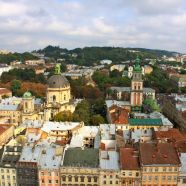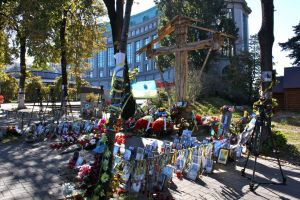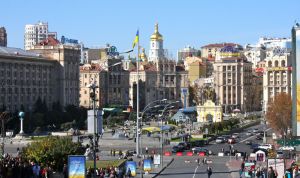
A view from the tower of city hall in L’viv, Ukraine. Photo by Trevor Erlacher.
Share This
Print This
Email This
A Year in Ukraine
What could be more fascinating for a historian than to personally witness a moment of rapid political and cultural change in the region of his or her focus? I lived in L’viv and Kyiv, Ukraine, during the 2014–15 academic year, in the aftermath of a popular uprising against the regime of Viktor Yanukovych. The ousted president fled to his handlers in Moscow, which all but declared war on Ukraine, annexing the Crimea and instigating a civil war, fueled by Russian troops and weaponry, on the country’s southeastern frontier. While in Ukraine, I conducted research in state archives and national libraries as a Fulbright fellow for my dissertation, an intellectual and cultural history of Ukrainian integral nationalism. I traveled by train from Uzhhorod to Kharkiv, absorbing Ukraine’s beautiful landscapes and cultural treasures, music, food, and drink, and honed my Ukrainian in the west and my Russian in the east. It was a life-changing and immensely productive experience that afforded me the opportunity to witness a nation in flux, mobilizing to face an existential threat.
The world is only beginning to see and feel the consequences of the unfinished revolution and ongoing war with Russia that erupted in Ukraine just months before my arrival that September. There could not have been a better time and place to reflect on the historical processes and ideas that have shaped the present watershed. I encountered a society that, despite these upheavals, epitomized wartime Britain’s best-known meme: Keep calm and carry on. Day-to-day life was almost placid. The Ukrainians whom I met were kind, generous, hardworking, constantly engaging in political debate, and deeply committed to their country and fellow citizens. Picking up the slack left by a corrupt and incompetent government and military, they organized themselves to acquire and deliver the food and supplies badly needed on the front in the Donbas region. Everyone I spoke with had at least one close friend or relative living or serving there. Others volunteered to go themselves or had been drafted.

A shrine to the “Heavenly Hundred,” those killed by police during the Maidan protests in Kyiv, Ukraine. Photo by Trevor Erlacher.
Just beneath the veneer of normalcy, however, new values, national cults, and simmering anxieties are everywhere apparent. Altars, street art, and monuments to the “Heavenly Hundred,” the fallen “Cyborgs,” and other heroes of the “Revolution of Dignity” dot the land and its cities. TV screens broadcast a constant stream of vexing news from the front. Signs of the death and devastation plaguing the country’s Russian-occupied southeast have become ubiquitous. Refugees and amputees are an increasingly common sight, like the advertisements for lawyers and prosthetics aimed at them. Many struggle to survive in the ever-worsening economy. Men return physically and psychologically damaged from a war zone where the torturing of POWs and “spies” is endemic. Domestic violence has increased, in some cases as a direct result of veterans’ brutalization in combat or captivity. The death toll continues to rise. Families mourn lost loved ones.
But the deeply held belief that all this suffering and sacrifice had damn well better be worth it undergirds the total metamorphosis promised by the revolution: on the one hand, an end to government corruption and decrepit bureaucracies, the rotten opulence and political domination of oligarchs, police brutality, censorship, and intimidation of the press, inescapable poverty, isolation from the wider world, and the slavish, fatalistic mentality this all engenders; on the other hand, the (re)birth of a confident, civic, unified nation, driven by ideals worth struggling for and a society of individuals made radically conscious of their own and collective power. What has actually been achieved along these lines is up for debate, and whether Ukraine will ever make it is yet to be seen, but the outcome will have grave implications for Russia and the rest of Europe as well.
However things develop on the international stage, everyday Ukrainians have demonstrated the enduring power of civil society and popular movements in the twenty-first century, and Americans of all regions and sects would be wise to take notice. The lesson is simple: if the people overcome their apathy and dread, and rally behind a common goal, then everything is possible, no matter the opposition. Stateside protest movements will never achieve the critical mass needed to transcend the status quo if Americans do not undergo an elevation of consciousness similar to the one that Ukrainians experienced at the beginning of 2014. Moving forward, Ukrainians look to the West, and the United States above all, for guidance, support, and exemplars of a better social and political order. Like most post-Communist countries, they still have much to learn about the way liberal democracy works. But how much have their would-be teachers forgotten about what it means to challenge authority and demand freedom, justice, and fairness? More, I fear, than we realize.
*Special thanks to the Canadian Foundation for Ukrainian Studies.







